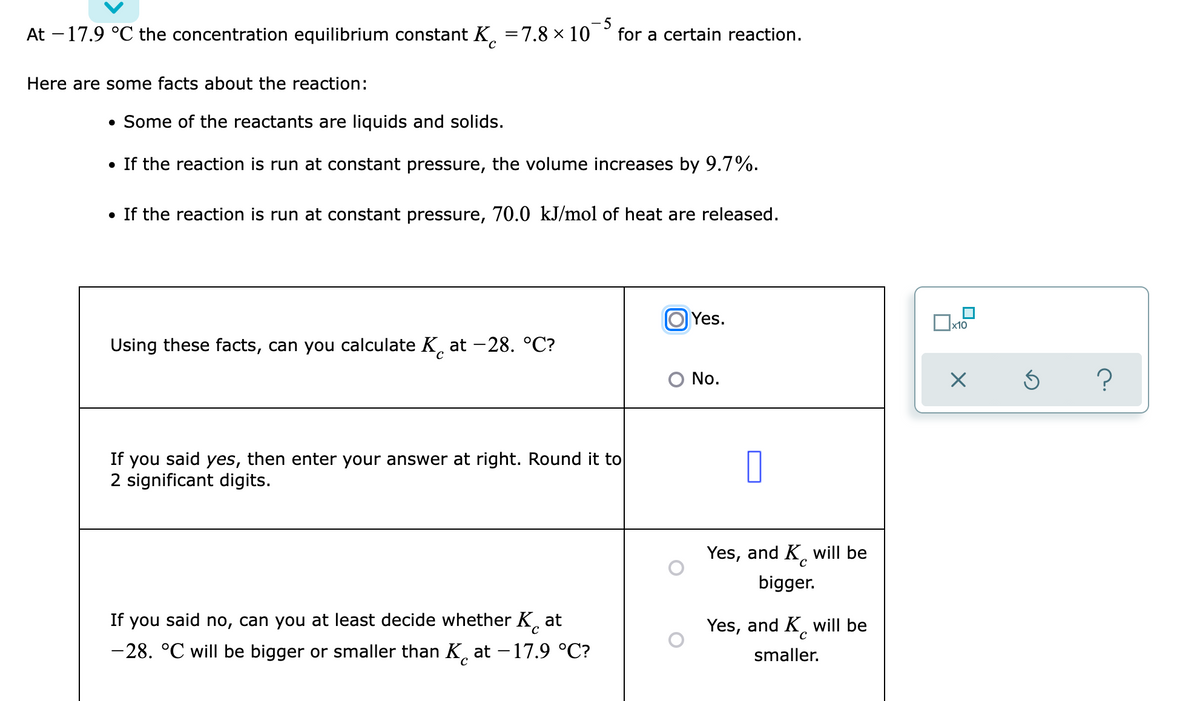At –17.9 °C the concentration equilibrium constant K =7.8 × 10 for a certain reaction. Here are some facts about the reaction: • Some of the reactants are liquids and solids. • If the reaction is run at constant pressure, the volume increases by 9.7%. • If the reaction is run at constant pressure, 70.0 kJ/mol of heat are released. O Yes. Oxto Using these facts, can you calculate K, at -28. °C? O No. If you said yes, then enter your answer at right. Round it to 2 significant digits. Yes, and K will be bigger. If you said no, can you at least decide whether K at Yes, and K will be -28. °C will be bigger or smaller than K at – 17.9 °C? smaller.
At –17.9 °C the concentration equilibrium constant K =7.8 × 10 for a certain reaction. Here are some facts about the reaction: • Some of the reactants are liquids and solids. • If the reaction is run at constant pressure, the volume increases by 9.7%. • If the reaction is run at constant pressure, 70.0 kJ/mol of heat are released. O Yes. Oxto Using these facts, can you calculate K, at -28. °C? O No. If you said yes, then enter your answer at right. Round it to 2 significant digits. Yes, and K will be bigger. If you said no, can you at least decide whether K at Yes, and K will be -28. °C will be bigger or smaller than K at – 17.9 °C? smaller.
Introductory Chemistry: A Foundation
9th Edition
ISBN:9781337399425
Author:Steven S. Zumdahl, Donald J. DeCoste
Publisher:Steven S. Zumdahl, Donald J. DeCoste
Chapter17: Equilibrium
Section: Chapter Questions
Problem 119AP
Related questions
Question

Transcribed Image Text:At -17.9 °C the concentration equilibrium constant K. =7.8 × 10
- 5
for a certain reaction.
Here are some facts about the reaction:
• Some of the reactants are liquids and solids.
• If the reaction is run at constant pressure, the volume increases by 9.7%.
• If the reaction is run at constant pressure, 70.0 kJ/mol of heat are released.
Yes.
x10
Using these facts, can you calculate K, at -28. °C?
C.
O No.
If you said yes, then enter your answer at right. Round it to
2 significant digits.
Yes, and K, will be
bigger.
If you said no, can you at least decide whether K, at
Yes, and K will be
-28. °C will be bigger or smaller than K. at – 17.9 °C?
smaller.
Expert Solution
This question has been solved!
Explore an expertly crafted, step-by-step solution for a thorough understanding of key concepts.
This is a popular solution!
Trending now
This is a popular solution!
Step by step
Solved in 2 steps with 2 images

Knowledge Booster
Learn more about
Need a deep-dive on the concept behind this application? Look no further. Learn more about this topic, chemistry and related others by exploring similar questions and additional content below.Recommended textbooks for you

Introductory Chemistry: A Foundation
Chemistry
ISBN:
9781337399425
Author:
Steven S. Zumdahl, Donald J. DeCoste
Publisher:
Cengage Learning

World of Chemistry, 3rd edition
Chemistry
ISBN:
9781133109655
Author:
Steven S. Zumdahl, Susan L. Zumdahl, Donald J. DeCoste
Publisher:
Brooks / Cole / Cengage Learning

Chemistry by OpenStax (2015-05-04)
Chemistry
ISBN:
9781938168390
Author:
Klaus Theopold, Richard H Langley, Paul Flowers, William R. Robinson, Mark Blaser
Publisher:
OpenStax

Introductory Chemistry: A Foundation
Chemistry
ISBN:
9781337399425
Author:
Steven S. Zumdahl, Donald J. DeCoste
Publisher:
Cengage Learning

World of Chemistry, 3rd edition
Chemistry
ISBN:
9781133109655
Author:
Steven S. Zumdahl, Susan L. Zumdahl, Donald J. DeCoste
Publisher:
Brooks / Cole / Cengage Learning

Chemistry by OpenStax (2015-05-04)
Chemistry
ISBN:
9781938168390
Author:
Klaus Theopold, Richard H Langley, Paul Flowers, William R. Robinson, Mark Blaser
Publisher:
OpenStax

Chemistry for Engineering Students
Chemistry
ISBN:
9781337398909
Author:
Lawrence S. Brown, Tom Holme
Publisher:
Cengage Learning

Chemistry: Principles and Reactions
Chemistry
ISBN:
9781305079373
Author:
William L. Masterton, Cecile N. Hurley
Publisher:
Cengage Learning

Introductory Chemistry: An Active Learning Approa…
Chemistry
ISBN:
9781305079250
Author:
Mark S. Cracolice, Ed Peters
Publisher:
Cengage Learning